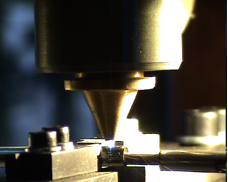Research and development of the technology of medical stents manufacturing by means of laser milling
We established that at laser stent manufacturing by means of direct laser milling technology there is a possibility to create “pockets” in the stent’s walls with given depth, shape and size. These pockets are used for drug deposition and could not be formed using ordinary laser cutting techniques. Moreover, it is also possible to wary the stent’s filament thickness (up to 20 mkm) thus increasing the flexibility and elasticity when filament’s width increases (from 0.5 to 1 mm).
Two schemes were developed to make use of the peculiarities of direct laser milling technique. With the first scheme, we use scanning of focused laser beam for workpiece processing that, in turn, rotates and moves longitudinally. With the second scheme rotational movement is done by the workpiece and laser beam moves longitudinally (just like with multiple pass turning).
There are also two ways of laser focusing that were used with two schemes mentioned above. With first focusing scheme laser beam is focused perpendicular to the workpiece surface (laser beam axis coincides with workpiece rotation axis). Filament’s wall would be as parallel as possible with this focusing scheme. With second laser focusing scheme laser beam is focused at some angle to the workpiece focus (laser beam axis does not coincide with workpiece axis of rotation). It is possible to process filament’s inner wall with this scheme.
It was established that best workpiece protection techniques at laser milling are:
− Assist gas delivery into the processing zone
− Installation of protection screen inside the workpiece
− Pumping of working liquid through the workpiece cavity
− Combination of three above mentioned techniques
There were established optimal processing regimes that allow to remove material layer by layer with removal step of 5 to 100 mkm with guaranteed roughness less than 2 mkm.

| Долучення | Розмір |
|---|---|
| 1.1 МБ |




